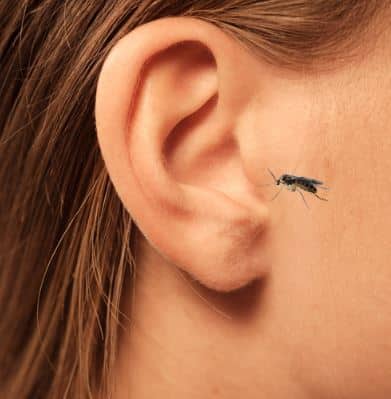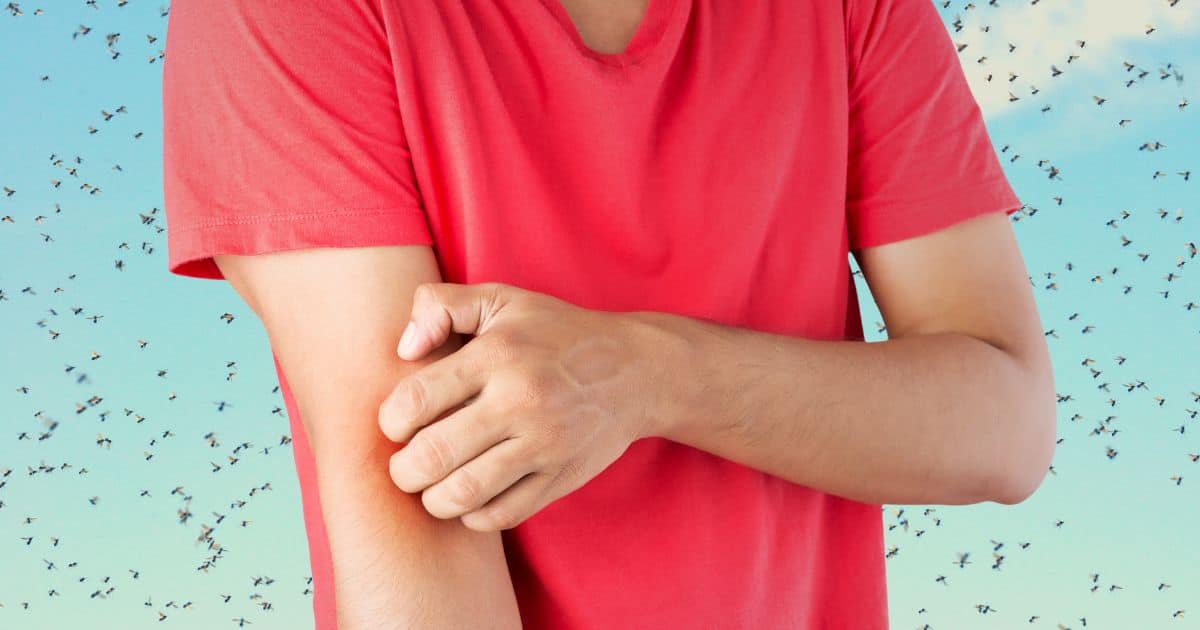This is a continuation blog from last week “My Battle With the Ear, No-See-Ums, and Textbooks, Part I.” Part I discussed the problems associated with cerumen and no-see-ums. Part II is an attempt to provide remedies that have been suggested to keep no-see-ums away from the ears since cerumen does not seem to be doing the job.
Officially, no-see-ums are biting midges. Even more officially, they are of the genus Culicoides, which I believe is Latin for nasty little boogers that irritate the hell out of you. They like water (moisture for larvae), dirt and grasses (nesting place), bushes and trees (another word for the human head) to live out their short but prolific life cycle.
And, when they bite, the itch feels like a hoard of Leprechauns with crème Brule torches making a Danger Boy Flambé! The no-see-ums are eventually sated, having drunk deeply on our blood, like Dracula on a three-day bender.
I heard of relief from bites being a bath in oatmeal and calamine lotion, pain reliever, antihistamine, and combined with beer and the euphoria of a newlywed honeymoon. The gentleman reported that by day three he was only scratching in public once every 10 minutes – almost normal for a human male.
Ways to Repel No-See-Ums (“flying teeth”) – Especially From the Ears
 The primary effort in managing these “flying teeth” by most individuals is to keep them out of the ears, where they are most annoying, especially since cerumen does not seem to repel them (insects) as our professional text books suggest. Deet and Picaridin-based products are reported to be effective as repellants. Some people complain that they are unpleasant to use, and therefore use Skin So Soft (Avon product) as a substitute. However, “real men” don’t ordinarily stoop so low as to use purchased products that may or may not work. That would be like asking for directions.
The primary effort in managing these “flying teeth” by most individuals is to keep them out of the ears, where they are most annoying, especially since cerumen does not seem to repel them (insects) as our professional text books suggest. Deet and Picaridin-based products are reported to be effective as repellants. Some people complain that they are unpleasant to use, and therefore use Skin So Soft (Avon product) as a substitute. However, “real men” don’t ordinarily stoop so low as to use purchased products that may or may not work. That would be like asking for directions.
Besides, Skin So Soft sounds like a contradiction as protection against a monster that cuts your skin with its jaws. Why make skin softer so that they can penetrate it more easily? There should be a more appropriate product and name for men – something like Skin So Tough!
Insect repellant should work. However, it often does not. You would think that repellents that include Deet or Picaridin, and combined with the supposed repellant action of cerumen would create a double dose of effectiveness – much like a boiler maker. But, that does not seem to be the case. (My apologies to readers who are not familiar with the ingredients of this concoction and recommend that they get a life).

And, because available commercial products don’t always seem to work, the search for the “holy grail” of no-see-ums repellants that really do the job takes many directions.
Effective No-See-Um Repellant
A few of the more interesting suggested approaches in our area that I and others have used or heard about follow:
1. The easiest way to deal with no-see-ums is simply to avoid the areas that have junipers for a month or two, but late May is otherwise one of the most pleasant times in Southern Utah.
2. Pray for windy days. No-see-ums are extremely temperature- and wind-dependent insects. The best defense is a good breeze. If you’re riding a bike to generate a breeze, keep your mouth closed. When moving rapidly the chances of no-see-ums in the ears is minimized, but the opportunity to eat on the fly is optimized.
3. Keep cool. Because no-see-ums seem to be temperature dependent, preferring warm temperatures, it may not be a good idea to look for repellents that include alcohol – especially that are taken internally. For example, just 12 ounces of beer increases your no-see-um appeal, possibly because of the increase in body temperature it causes, or because skin markers change when metabolizing cocktails. This has not been tested appropriately but might make a good Capstone study for an adventurous audiologist.
4. No-see-ums also are believed to be drawn to people and animals by our carbon dioxide emissions (like when we breathe out). If this is how they find us, the alternative of not breathing to avoid them seems like an extreme, but successful long-term approach.
5. Try chasing them from your ears by swatting from one ear to the next. This requires a constant motion, probably does not generate enough turbulence to fly, but is does make you look like a person trying to slap yourself silly. Also, instinctive, hand slaps to the ear to kill them produces sudden and increased air pressure changes that could lead to hearing damage. And, a side effect is that these uncontrollable rapid slaps also have a tendency to bend your glasses temples. Regardless, no-see-ums refer to this dance that humans do to avoid them, the “Smackerena.” Having lived in the north for about 14 years, I had lots of experience with mosquitoes and black flies. While both are annoying, they’re at least big enough to see, and so you stand a chance of killing them. But no-see-ums are so tiny as to be quasi-invisible; you wave, swat, and swear but you almost always miss them.
6. Avoid being out in the daylight. They do disappear shortly after sundown, but that leaves the issue of what to do with the 16-hour days to be enjoyed. Could this be called a Draculian approach?
7. Because they are lousy fliers, situate yourself at least 300 feet from Juniper trees since this tends to be their typical flying range. However, this is one thing that has always bugged me about these little perverts – why aren’t they in town? In the outback they can drive you bonkers. But, if you go into town in the same area/climate, they completely disappear. Why should this be? If they are so hot for a blood meal, why don’t they just zip into town where there are people (and pets) galore as a smorgasbord to feed upon?
8. Circumaural ear muffs. These are 100% effective for keeping no-see-ums from the ear, regardless of their NRR (noise reduction ratings). They are too warm for many people, but are applied with no mess, do not require a shower when removed (unlike most of the other concoctions often recommended), and continue to allow for selective listening. These are personally my #2 recommendation.
9. Change your odor. Scientific research has shown that if you are frequently bitten by no-see-ums, it is because of the smell you give off. If a person is rarely bitten, then his or her body gives off a smell (actually a chemical) that masks the scent that attracts no-see-ums. Commercial repellents work on this principle. They mask the attractive body odor that the insects like. Based on this knowledge, I purchased a canary to perch on my shoulder to see if perhaps no-see-ums would switch hosts and not bother me any more (the canary seems to be of assistance to miners, so why not me?) I thought also that even if nothing else, the canary might find the no-see-ums as a food source. Unfortunately, the poor bird was tormented too, as was I. It would aggressively peck at itself, flap its wings, and deposit unmentionables on my shoulder, creating a quadruple dose of irritation to me. So, I had to get rid of the bird. My surrogate host theory was a dismal failure.
People have tried all kinds of homemade repellents but no-see-ums just seem to evolve around them. Take Garlic. Yeah, that knocks out most of them, but the 2% that force their way past it will probably live to breed a super batch of babies that eat garlic for lunch. This evolving factor is said to have taken place for lemon and pure vinegar too. Likewise, my cans of Buzz Away worked at first but after a month it was like a scent that merely told the buggers where I was hiding. I think the citronella in it became a kind of food for them.
10. Flypaper. Creed and Negus (1926) concluded that cerumen’s protective function was to prevent the entrance of dust and insects into the ear canal, acting like a type of “flypaper.” If that is true, then why not find a way to use flypaper to capture no-see-ums? The problem was how to position flypaper near the ear. Attaching it to a cap as sort of a hatband seemed to be a logical approach – that is until you slap at no-see-ums at the ear (involuntary reaction) and get caught in the flypaper. The only catch was a large “big-see-um” human dummy. Additionally, when the wind blew, all kinds of debris were captured on the flypaper making it look like some kind of ‘60s hippy headgear.
11. I’ve rubbed Bounce dryer sheets on my ears and head and smelled like a Laundromat, and I think I could hear the no-see-ums laughing through their buzzing.
12. Gin. This was another attempt to mask body odor. In a pinch, Gin (as in Gin and Tonic) works fairly well at keeping no-see-ums away, but it has to be reapplied fairly often. It is probably best if this is administered internally rather than applied directly to the skin. The reason for this is if applied to the skin, the drunken no-see-ums lose their ability to fly and then bite your ankles.
13. Cigar Smoke. These should be big old smelly stogies that really make you sick, none of them wussy Tampa Jewels. After about an hour of smoking the no-see-ums should be gone. However, you would probably not know because you would be too dizzy to walk, and you’d wonder if having to replace your stinky clothes was worth it.
14. Head net. Yes, it looks dorky, but after an hour of wearing you won’t care. This is my #1 solution because it fits over a broad-rimmed hat, is ventilated, keeps no-see-ums away from the ears and even their secondary targets on the head as well. However, the screening must be very fine to prevent the combatants from passing through. Most mosquito nets have mesh that is too large.
15. Other anecdotal repellent ideas: orange peel, any citrus juice, eucalyptus oil, coconut oil, avocado oil mixed with Dettol, baby oil mixed with Dettol, Chinese herbal oil, essential lavender oil, tea tree oil, Listerine, Tiger Balm, Eucalipto, Vicks VaporRub, vinegar, marmite, promite, vegemite (anything with high vitamin B content), lemon eucalyptus oil, pennyroyal oil, rubbing area with inside of banana peel, Berocca, crushed leaves from the Ngaio tree, vitamins B, B1, B6, B29 (sorry, got carried away with the B’s), and just about any other item you can think of, regardless of how remotely related or how rare it is.
Summary
The fact that so many approaches have been tried would seem to indicate that cerumen as an ear defense against insects is not working, as identified in the literature.
Hopefully, our future related to this issue will not be seen as a case of the blind leading the blind.






